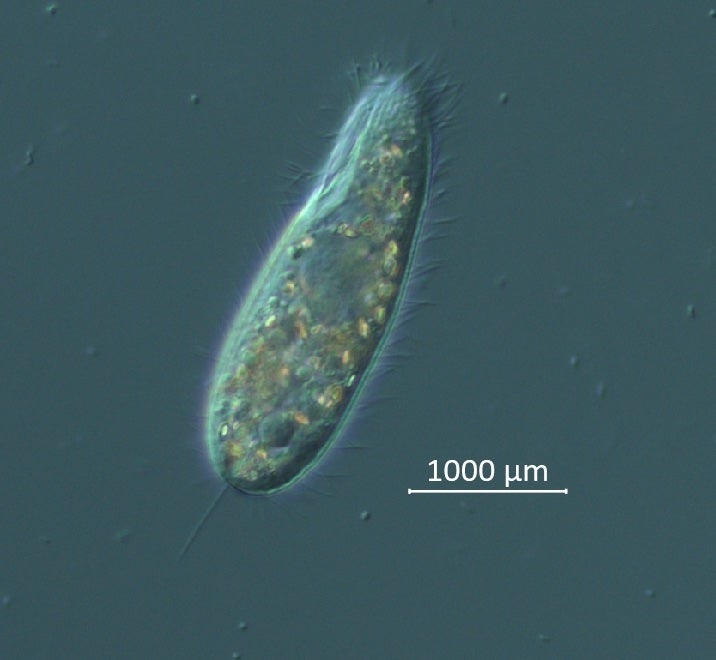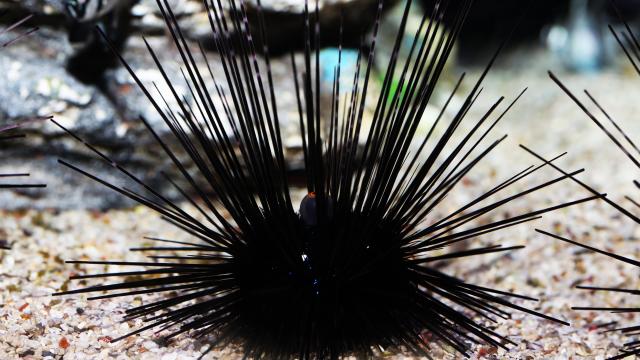A team of scientists say they’ve figured out the cause of a devastating sea urchin die-off that occurred last year along the waters of the Caribbean Islands and Florida. The algae-eating sea urchins were likely wiped out by microscopic organisms known as ciliates. While the mystery has been solved, it’s not clear exactly how the outbreak started, and the die-off will have dire long-term effects on the region’s coral reefs and ecosystem.
In January 2022, populations of Diadema antillarum, also known as the long-spined sea urchin, throughout the Caribbean Sea began to rapidly and massively decline. The first known outbreaks were found along the U.S. Virgin Islands, but they would eventually be seen as far west as Mexico and as far north as the coast of Southern Florida, according to the Atlantic and Gulf Rapid Reef Assessment (AGRRA). In some areas, as much as 98% of the population is thought to have died.
Marine researchers first noticed the deaths in February 2022. Within a month, AGRRA and others organised a collaborative effort to collect data and hopefully trace the source of the die-off, known as the Diadema Response Network. It was this teamwork that helped the researchers behind the new study, published Wednesday in Science Advances, find the urchin killer as soon as they did, according to study author Mya Breitbart, a biologist at the University of Southern Florida.
“It’s extremely rare to identify the causative agent for most marine invertebrate diseases, and a typical timeline for figuring it out would be years or even decades. One of the most astonishing parts of this research for me was how quickly we were able to identify the ciliate,” she told Gizmodo in an email. “This was in large part facilitated by an excellent team of interdisciplinary collaborators, which included multiple universities, government agencies, and non-profit groups.”

Among other things, Breitbart and her team had access to urchin samples from over 20 sites. Microscopic and genetic analysis then revealed the presence of the ciliate in affected animals. Ciliates are a broad group of free-living protists characterised by the cilia (hair-like projections) that they use to move.
They were also a bit lucky, Breitbart said, because they were able to isolate the ciliates found in sick urchins and successfully grow them in the lab. This allowed them to conduct experiments showing that sea urchins in the lab became sick and died in a similar way to those found in the outbreak when exposed to the ciliates (the most distinctive symptom being the falling off of their spines). A new generation of ciliates then grew rapidly inside the lab urchins and could be isolated from them again.
These experiments are the same sort of detective work used to prove that a suspected germ causes disease in humans or land-dwelling animals, but they are typically much harder to do with sea life, Breitbart said. “This process, known as Koch’s postulates, is rarely achieved for marine diseases and is an accomplishment we are especially proud of.”
Long-spined sea urchins are a crucial species in their shallow tropical environments, since they eat and keep algae populations in check that might otherwise threaten the survival of coral reefs. While some populations worldwide are still abundant, it’s been a rough time for them in the Caribbean specifically. In the 1980s, there were similar mass die-offs that are thought to have killed up to 98% of urchins in the region. This earlier die-off is considered one of the major factors in the area’s decline of healthy coral reefs since. Over the past 40 years, these urchins have made a noticeable but slow recovery, with their numbers perhaps returning to 12% of their original strength. But virtually all of that progress has now been erased in outbreak areas, along with the environmental benefits they brought along.
“Based on the 1980’s die-off, we expect that the loss of these urchins in the 2022 event will lead to algal overgrowth on affected coral reefs, with wide-reaching effects for the ecosystem,” Breibart said.
There are a few silver linings. The outbreaks seem to have stopped since last fall and winter, according to Breitbart. There’s also no evidence that other urchin or marine species have been directly affected by the ciliates. And some urchins did survive their local outbreaks, while some areas of the Caribbean appear to have escaped exposure altogether.
At the same time, many questions remain. The species of ciliate identified by the scientists belongs to a group known as scuticociliates, some of which have been known to cause disease in other marine animals, including sharks. And given the eerie similarity between last year’s die-off and the one in the 1980s, this species might be a sea urchin serial killer. But it’s not known how these outbreaks were sparked or even how the disease spread so quickly. Breitbart notes that many initial cases were found at harbours and ports, and sometimes outbreaks seemed to happen after large amounts of rainfall — potential clues that could be worth following up on. And by simply identifying the culprit now, Breitbart and her team hope that we’ll eventually be able to proactively protect the long-spined sea urchin.
“We believe that knowing the cause of the disease, combined with future efforts to understand more about the factors leading to the outbreak and exploration of potential treatments, will enable us to help protect the remaining urchins and give coral reefs a fighting chance,” she said.
